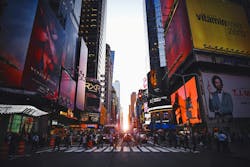New York’s new ‘czar of public space’ ramps up pedestrian and bike-friendly projects
Having made considerable strides to make streets more accessible to pedestrians and bikers in recent years, New York City is continuing to build on that momentum.
Ya-Ting Liu, the city’s first public realm officer, is shepherding $375 million in funding earmarked for projects intended to make the city more environmentally friendly and boost quality of life. The projects will produce more pedestrian plazas on congested streets, wider sidewalks, more bike lanes, and expanded public space.
Community advocates are hopeful that the new position, a kind of “czar of public space,” will speed up progress on these initiatives.
One example: Work wrapped up in June on the first phase of the Mayor’s Broadway Vision Plan. This project added two new plazas and a two-way bike lane along Broadway from West 25th Street to West 32nd Street. The next phase of the plan calls for extended curbs and widened crosswalks to make it easier for vehicles to do pickups and drop-offs without blocking traffic. This project will stretch about 2.8 miles.
Across the East River in Queens, a stretch of Jamaica Avenue now includes granite blocks, tables, chairs, and planters. This space is meant to encourage people to sit, eat, read, and meet friends. This stretch of roadway will also get wider sidewalks, extended curbs, and elevated crosswalks.
Liu’s mission includes bringing equity to projects so that neighborhoods and boroughs all across the city benefit. Liu says the pandemic has sharpened the focus on the importance of having vibrant, inclusive public spaces, according to a report by Bloomberg.
